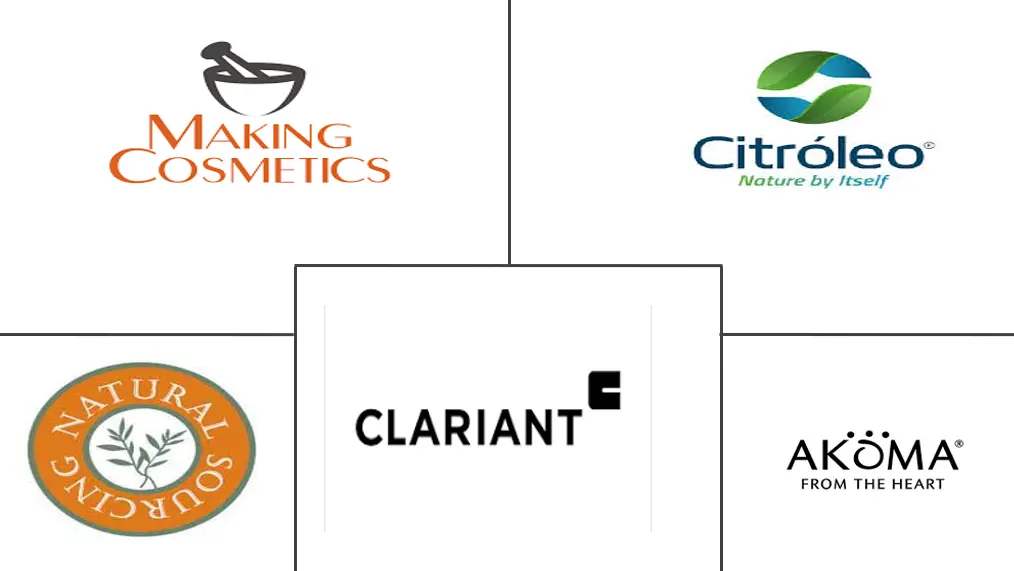Murumuru Butter Market Size and Share
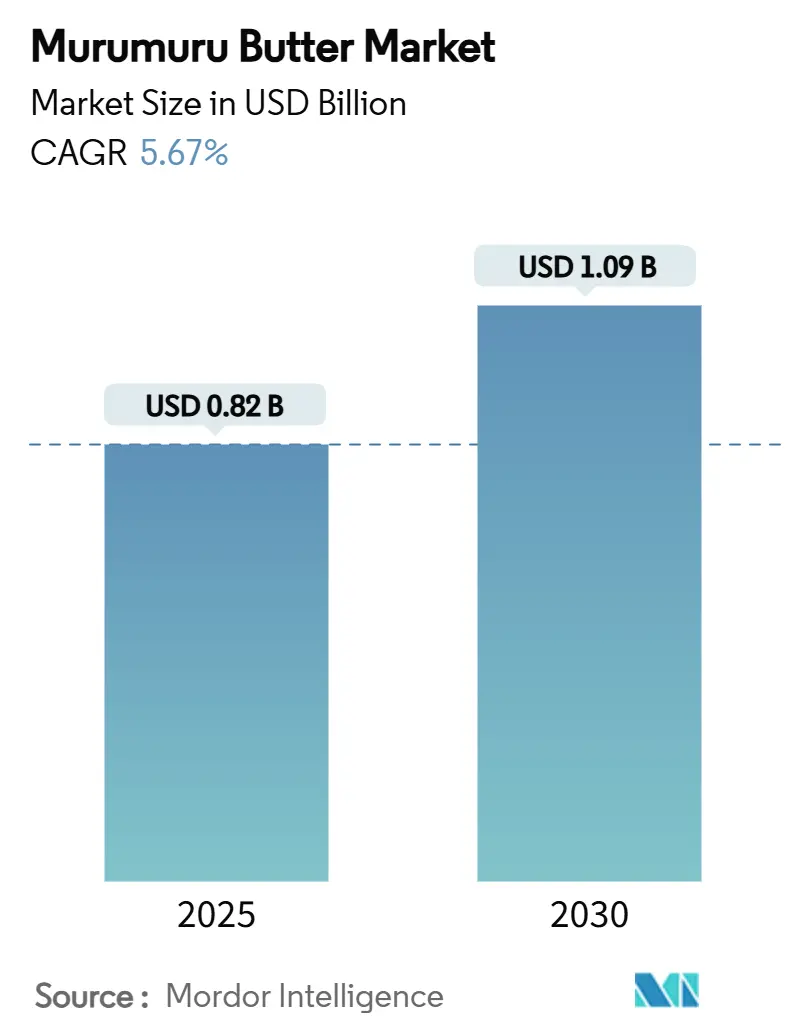
Murumuru Butter Market Analysis by Mordor Intelligence
The market size for murumuru butter is anticipated to reach USD 0.82 billion in 2025 and is on track to climb to USD 1.09 billion by 2030, reflecting a 5.67% CAGR over the forecast period. Strong consumer enthusiasm for plant-based emollients, tighter ingredient-disclosure rules, and the clean-beauty push are combining to lift demand, especially in premium hair-care and skin-care lines. North America’s early embrace of sustainable ingredients, reinforced by the FDA’s Modernization of Cosmetics Regulation Act of 2022, underpins regional leadership[1]Source: U.S. Food and Drug Administration, “Guidance for Industry – Registration and Listing of Cosmetic Product Facilities and Products,” fda.gov. Asia-Pacific is expanding faster, supported by rising incomes, growing e-commerce penetration, and high receptivity to novel beauty formats. Brands are also promoting murumuru butter in waterless bars and multi-use products that cut packaging waste and simplify routines. At the same time, traceable Amazon sourcing and community partnerships have become essential differentiators that justify premium pricing.
Key Report Takeaways
- By category, the conventional segment led with 78.64% of the murumuru butter market share in 2024, while the organic segment is forecast to post an 8.76% CAGR to 2030.
- By form, refined/deodorized murumuru accounted for 62.18% of the 2024 market, whereas virgin grades are projected to expand at a 7.83% CAGR through 2030.
- By end-user industry, personal care and cosmetics held 71.45% of the murumuru butter market size in 2024, and food & beverages is expected to grow at a 6.09% CAGR during the same horizon.
- By distribution channel, offline retail dominated with 68.24% share in 2024, yet online retail is predicted to record a 7.14% CAGR to 2030.
- By geography, North America captured 37.69% of the 2024 market, while Asia-Pacific is anticipated to register an 8.31% CAGR through 2030.
Global Murumuru Butter Market Trends and Insights
Drivers Impact Analysis
| Driver | (~) % Impact on CAGR Forecast | Geographic Relevance | Impact Timeline |
|---|---|---|---|
| Plant-based emollients in premium hair-care | +1.2% | North America & Europe, expanding to Asia-Pacific | Medium term (2-4 years) |
| Clean-beauty waterless bars | +0.8% | Global, with early adoption in North America & Europe | Short term (≤ 2 years) |
| Personalized and multi-use beauty | +0.9% | Global, led by North America and Asia-Pacific | Medium term (2-4 years) |
| Functional anti-aging and barrier claims | +1.1% | Global premium segments | Long term (≥ 4 years) |
| Adoption in high-performance hair-/skin-care | +0.7% | North America & Europe, expanding to Asia-Pacific | Medium term (2-4 years) |
| Vegan, cruelty-free, plant-based formulations | +0.6% | Global, strongest in Europe and North America | Long term (≥ 4 years) |
| Source: Mordor Intelligence | |||
Rising Demand for Plant-Based Emollients in Premium Hair-Care Lines
Luxury hair-care brands increasingly rely on murumuru butter to swap out silicones and petroleum-based emollients. Lauric-and myristic-acid content delivers lightweight conditioning without buildup, which supports product claims around frizz control and gloss retention. BASF’s 2025 climate-adaptive launch spotlighted the ingredient as part of its sustainable emollient toolkit[2]Source: BASF, “BASF Unveils Climate-Adaptive Beauty at Cosmet'Agora 2025,” basf.com. North American and European labels pay a premium for traceable supply, enabling Amazon-based cooperatives to receive higher farm-gate prices and long-term contracts. Retail marketing stresses rainforest preservation and community income, which resonates with eco-aware shoppers. Supply partners that can issue batch-level certificates and life-cycle data are winning inclusion in new-product briefs.
Growing Adoption in Clean-Beauty “Waterless” Bar Formats
Solid shampoo, conditioner, and lotion bars eliminate 60-80% of the water used in traditional products, cutting freight emissions and plastic packaging. Murumuru butter’s semi-solid consistency stabilizes these bars, removing the need for synthetic waxes and thickening polymers. Europe, which accounts for more than 80% of global natural-cosmetics sales, remains the launchpad for waterless formats, encouraged by retailers’ zero-waste shelves. Its natural antimicrobial profile lengthens shelf life, helping brands forgo parabens and phenoxyethanol without compromising microbiological safety. Smaller indie labels leverage the butter’s recognisable Amazon story to build distinct brand identities in crowded clean-beauty aisles. As mainstream groups acquire such startups, scale efficiencies are expected to lift overall demand.
Rise of Personalized and Multi-Use Beauty Products
Direct-to-consumer brands employ AI-powered skin- and hair-diagnostic tools that mix murumuru butter with targeted actives in the same base. Asia-Pacific’s USD 190 billion beauty sector exemplifies this shift, championing subscription services that ship custom sticks, balms, and creams[3]Source: BDA Partners, “The Beauty Sector Is Growing and Glowing in Asia,” bdapartners.com. Murumuru butter’s compatibility with peptides, botanical extracts, and UV filters enables cross-category claims—hydration, anti-aging, and split-end repair in one SKU. The approach reduces the number of daily products, appealing to minimalist routines popular with Gen Z consumers. Manufacturers, in turn, enjoy lower inventory costs and faster product-development cycles because a single butter base suits multiple formulas.
Shift to Vegan, Cruelty-Free, and Plant-Based Formulations
European legislation continues to tighten around animal-derived ingredients and animal testing, pushing brands to plant alternatives. Murumuru butter fills gaps left by lanolin and beeswax without compromising texture. Certification bodies such as the Vegan Society accept the butter when sourcing is free of animal exploitation, widening its marketability across ethical-beauty shelves. Cruelty-free labeling opens shelf space in specialty chains that ban animal-tested inputs, giving murumuru-based SKUs priority placement. The shift also resonates in North American big-box retailers that have launched dedicated clean-beauty aisles. Over time, these ethical normals are expected to flow into Asia-Pacific regulations, generating additional upside.
Restraints Impact Analysis
| Restraint | (~) % Impact on CAGR Forecast | Geographic Relevance | Impact Timeline |
|---|---|---|---|
| High extraction and production costs | -0.9% | Global, especially price-sensitive markets | Short term (≤ 2 years) |
| Amazon supply-chain disruptions | -0.7% | Regions dependent on Brazilian imports | Medium term (2-4 years) |
| Stringent regulatory compliance | -0.5% | North America & Europe, expanding globally | Long term (≥ 4 years) |
| Harvest-yield price volatility | -0.6% | Global, seasonal variations affect all markets | Short term (≤ 2 years) |
| Source: Mordor Intelligence | |||
High Cost of Production and Extraction
Harvesting kernels from wild Astrocaryum murumuru palms is labor-intensive, often performed by indigenous communities deep inside the Amazon. Cold-press extraction under low-temperature controls is required to retain lauric acid and sterols, causing costs to run 3-5 times higher than synthetic emollients. Smallholder cooperatives must invest in GMP-compliant facilities to access international markets, adding capital expenditure burdens. These economics inhibit murumuru adoption in value brands whose margins cannot absorb high input costs. Exchange-rate fluctuations further complicate price stability, prompting some formulators to limit usage levels per SKU.
Supply Chain Disruptions and Volatility
All commercial murumuru butter sources trace back to the Brazilian Amazon, making the supply chain vulnerable to climate-driven flooding, road blockages, and rare-fruiting cycles. Brazilian port congestion and long inland transport routes add lead-time uncertainty, causing brands to increase minimum stock levels and raise working-capital needs. Deforestation crackdowns and indigenous land-right disputes can halt harvesting permits without warning[4]Source: World Rainforest Movement, “The Struggle for Land in the Brazilian Amazon Region Against Palm Oil and Mining Corporations,” wrm.org.uy. These risks deter large FMCG groups accustomed to just-in-time logistics, hampering rapid scale-up when demand spikes. Blockchain tracking pilots aim to provide transparency, yet high deployment costs restrict adoption among smaller cooperatives.
Segment Analysis
By Category: Conventional Dominance Drives Market Stability
In 2024, conventional grades dominated the murumuru butter market, holding a 78.64% share, bolstered by established rendering infrastructures and widespread acceptance of certifications. These grades leverage cost efficiencies, allowing them to penetrate both masstige and mass-market SKUs without significantly hiking retail prices. While organic-certified murumuru holds a smaller market share, it's on track to outpace its conventional counterpart, boasting an impressive projected CAGR of 8.76%. This surge is attributed to eco-labels commanding premium shelf space in the clean-beauty aisles. Brands are actively promoting their organic origins, not just to bolster narratives around rainforest preservation but also to secure prime merchandising spots in natural-food retailers. Furthermore, with Europe's tightening due diligence laws, a gradual shift towards certified organic supplies is anticipated, potentially curtailing the conventional segment's dominance in the murumuru butter market.
The intricate sourcing process elucidates the cautious adoption of certified grades: cooperatives face stringent audit requirements, tracing the journey from farm to finished butter. Any lapse in this chain jeopardizes their hard-won certification. Yet, the allure of premium margins drives producers to prioritize compliance and training. Donor-funded capacity-building initiatives play a pivotal role in bridging existing knowledge gaps. To mitigate risks of ingredient shortages leading to product delistings, beauty conglomerates are entering into multiyear offtake agreements, securing their organic volumes. In North America and Europe, the positive consumer sentiment surrounding fair-trade premiums lends credence to the price differentials. This evolving landscape is poised to bolster the growth trajectory of organic variants in the murumuru butter industry.
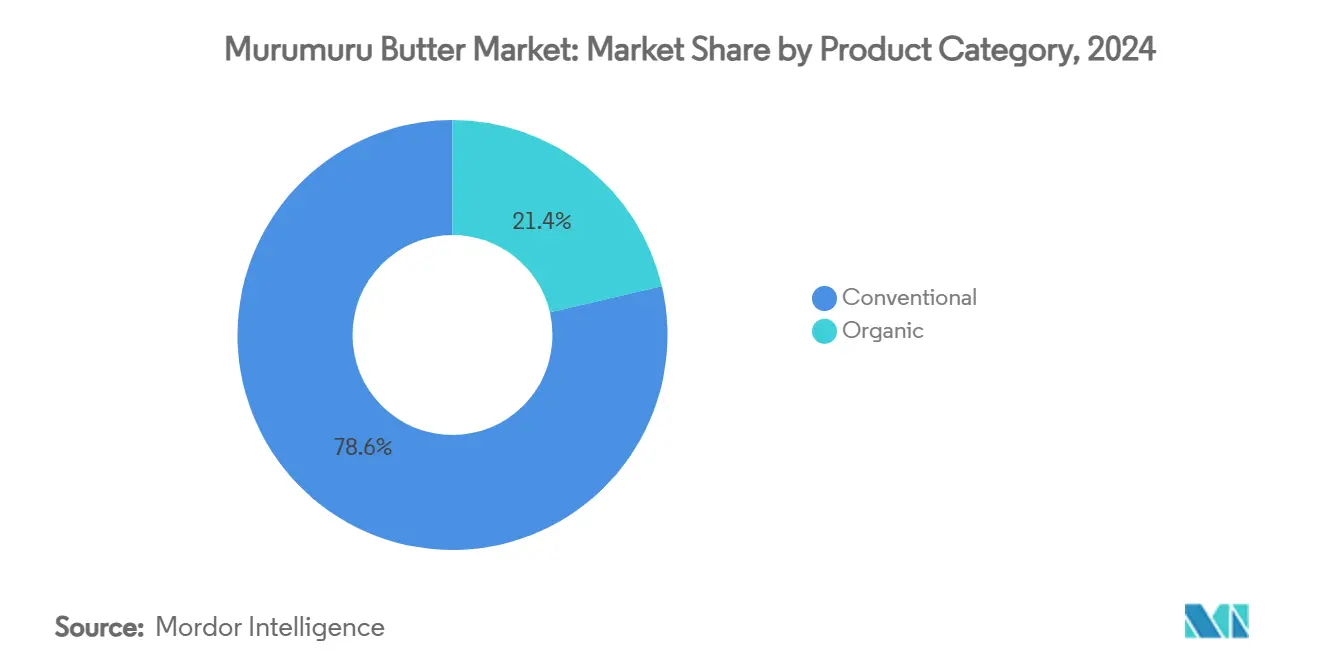
By Form: Refined Products Lead Despite Virgin Growth
In 2024, refined or deodorized murumuru butter commanded a dominant 62.18% market share. Cosmetic labs favor its neutral scent and consistent pale-yellow hue, which simplifies color matching in finished products. Suppliers employ low-temperature steam stripping to eliminate volatiles, ensuring the emollient performance remains intact, bolstering its market leadership. On the other hand, virgin butter is set to grow at an annual rate of 7.83%. Clean-beauty enthusiasts equate minimal processing with authenticity. Its distinct, richer yellow hue and nutty fragrance set apart artisanal variants found in specialty boutiques. Formulators leverage its elevated antioxidant content to bolster claims of natural integrity and reparative benefits, cementing its premium status.
Processing choices influence supply dynamics: Refined lines can handle mixed kernel lots, boosting throughput and yield. In contrast, virgin butter demands meticulous fruit selection and expedited transport. Brands gravitate towards refined grades for economy-size lotions, prioritizing olfactory neutrality, while opting for virgin in balm sticks where sensory nuances take precedence. Both variants are integral to the murumuru butter market, enabling manufacturers to customize textures for both leave-on and rinse-off products. Investments in continuous-batch deodorization at Brazilian facilities are poised to enhance refined capacity, even as community-run micro-presses see a surge in niche virgin production.
By End-User Industry: Personal Care Dominance with Food Growth
In 2024, personal care and cosmetics dominated the murumuru butter market, accounting for 71.45%. Key products driving this trend included hair masks, solid shampoos, and luxurious body butters. The butter's low-spread friction coefficient is a boon, offering easy combing and anti-frizz benefits, especially sought after in textured-hair segments. Meanwhile, the food and beverage sector emerged as the fastest-growing application, boasting a 6.09% CAGR. Producers of clean-label snacks and confections are turning to murumuru butter, drawn by its smooth melt and a melting point of 50-60 °C, positioning it as a viable alternative to cocoa butter[5]Source: Cargill, “Cargill to Launch Sustainable Cocoa Butter,” cargill.com. Brands in functional nutrition are highlighting murumuru's medium-chain triglycerides, promoting them for quick energy boosts, particularly in keto and paleo offerings. Culinary innovators are also taking note, appreciating the butter's oxidative stability, which allows for high-temperature baking without compromising flavor.
Pharmaceuticals are showing a keen interest, especially in topical barrier-repair ointments. These ointments often blend murumuru butter with zinc oxide, targeting diaper-rash relief and wound-healing applications. In the home-care sector, there's a push towards experimenting with murumuru butter. It's being tested as a natural wax substitute in dish-washing tablets and furniture polishes, a move that aligns with the industry's low-VOC targets. While biofuel research is still in its infancy, there's ongoing exploration. The high lauric content of murumuru butter has led to pilot programs, particularly for aviation bio-kerosene blends. However, the commercial viability of murumuru butter as a feedstock remains challenged due to its higher costs compared to cheaper vegetable oils. This cross-industry adoption underscores the expanding influence of the murumuru butter industry, stretching far beyond its traditional cosmetic roots.
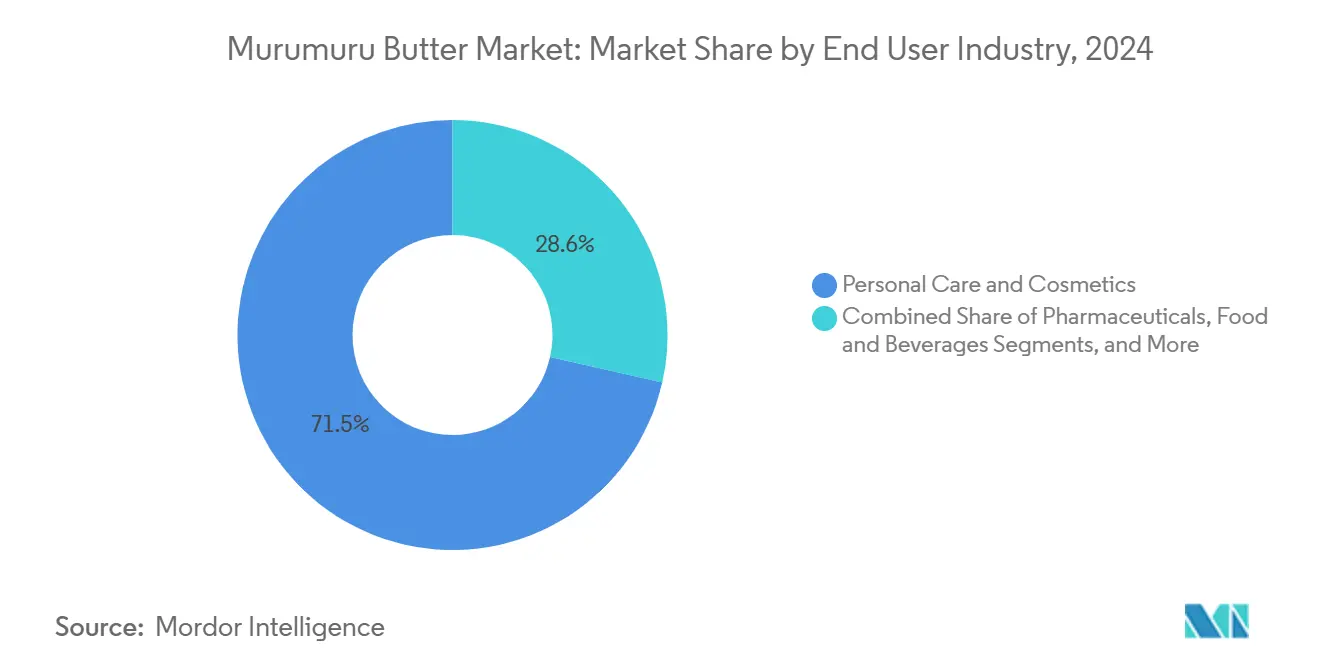
Note: Segment shares of all individual segments available upon report purchase
By Distribution Channel: Offline Retail Maintains Lead Despite Digital Growth
Specialty beauty chains, pharmacies, and supermarket natural aisles together made up 68.24% of 2024 sales, reflecting consumer preference for tactile interaction before purchase. Sales associates use in-store testers to demonstrate murumuru’s silky texture, boosting conversion rates. However, online marketplaces and brand-operated websites are growing at 7.14% CAGR, assisted by social-commerce influencers and try-before-you-buy sampling programs. E-tailers highlight rainforest-origin stories through video content, compensating for the lack of physical touch. Subscription box services include mini murumuru bars, promoting trial among eco-curious audiences, and feeding repeat purchases via auto-replenishment.
Digital channels also shorten feedback loops; brands harvest real-time customer reviews to tweak formulas, packaging, and marketing claims inside agile sprint cycles. Loyalty programs collect zero-party data on skin-type preferences, letting marketers send targeted promotions for products rich in murumuru butter. Logistics providers improve cold-chain last-mile delivery to prevent melting in warmer climates, expanding geographic reach. Offline-to-online synergies emerge through click-and-collect options that drive store footfall, ensuring the murumuru butter market remains omnichannel in nature.
Geography Analysis
In 2024, North America held a commanding 37.69% market share, driven by a surge in premium beauty spending, a robust clean-beauty retail framework, and the implementation of MoCRA, which emphasizes the importance of traceable natural inputs. The U.S. stands at the forefront, especially with multicultural hair-care brands catering to textured-hair consumers, who are now turning to murumuru for its lightweight yet sealing lipid properties. Meanwhile, Canada showcases a notable per-capita demand in its burgeoning natural-products sector, and Mexico's rising middle class is increasingly drawn to lifestyle-centric beauty products. Suppliers in the region are prioritizing carbon-neutral logistics, utilizing direct Amazon-to-Houston shipping routes to minimize transit emissions.
Asia-Pacific, while currently smaller, is on a rapid ascent, boasting an impressive 8.31% CAGR projected through 2030. Leading the charge, China is witnessing a surge in demand for digitally native premium brands, particularly those offering solid shampoos and hybrid skin-body balms infused with murumuru butter for an added touch of luxury. In India, the e-commerce boom, coupled with a growing preference for herbal ingredients, is positioning murumuru as a favored alternative to traditional shea and mango butters. Japan, known for its high-functionality market, is incorporating murumuru butter into its Barrier-RX sticks, targeting users of long-wear cosmetics. Australia's stringent rainforest-sourcing regulations align seamlessly with its transparent supply chains, bolstering its presence in natural-health outlets.
Europe, with its established natural-cosmetics market, commands over 80% of the global clean-beauty retail space. The region's alignment with the European Green Deal underscores a heightened demand for materials free from deforestation concerns. Germany leads the pack, with drugstore chains prominently featuring private-label creams infused with 10-15% murumuru. In France, contract-manufacturing hubs are stocking up on murumuru butter, catering to indie skin balms adjacent to perfumery. Despite facing post-Brexit customs challenges, the U.K. continues to see robust demand in the prestige e-commerce sector. Furthermore, as tourists increasingly seek out locally crafted products enriched with exotic Amazon ingredients, Southern European nations are expanding their footprint in this lucrative market.
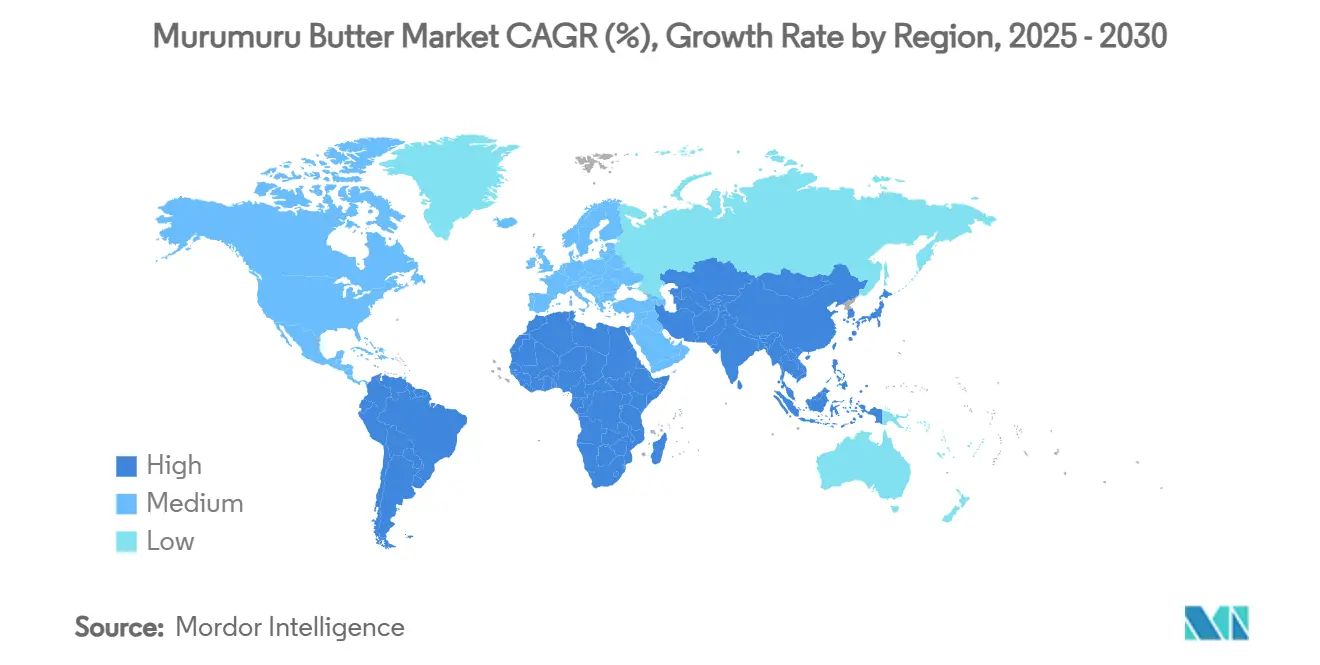
Competitive Landscape
The murumuru butter market is moderately concentrated, with top players like Clariant (Beraca), Citróleo Group, AAK AB, Natura &Co, and Cargill Beauty balancing scale and differentiation. Clariant taps into Beraca’s Amazon social-biodiversity network, supplying RSPO-aligned butters, all verified through blockchain traceability. Natura, through its Amazônia Viva program, invests EUR 300 million in forest-conservation projects, bolstering community-based sourcing and reinforcing its integrated brand pipeline. AAK AB employs enzymatic interesterification to customize melting profiles, eyeing confectionery cross-selling opportunities.
Technology adoption is becoming a significant advantage: Natura's use of near-infrared spectroscopy authenticates butter purity in mere seconds, slashing QC time from two hours to under ten minutes. Cargill's 2025 launch of sustainable cocoa butter hints at its ambition to diversify its specialty lipid offerings, providing formulators with dual plant butters in a single supply deal. Citróleo stands out with its proprietary cold-press machinery, which preserves phytosterols, enabling it to secure niche organic and fair-trade contracts. M&A activity is lively, with major cosmetic-ingredient firms eyeing specialized Amazon-derived portfolios to fulfill their ESG commitments.
New players, like small-batch Brazilian cooperatives, are leveraging online B2B platforms for direct-to-brand sales, bypassing intermediaries for better margins. Indie beauty brands, backed by crowd-funding, are crafting exclusive small-lot formulations of single-origin murumuru, employing transparent pricing to appeal to ethically conscious consumers. The competitive landscape is moderated by the limited availability of raw materials, which constrains market share expansion for even the most aggressive players. Ultimately, competition hinges more on securing a certified sustainable supply than on price wars, ensuring profitability in the murumuru butter market.
Murumuru Butter Industry Leaders
-
Clariant
-
MakingCosmetics Inc.
-
Natural Sourcing LLC
-
Akoma International UK Limited
-
Citroleo Group
- *Disclaimer: Major Players sorted in no particular order
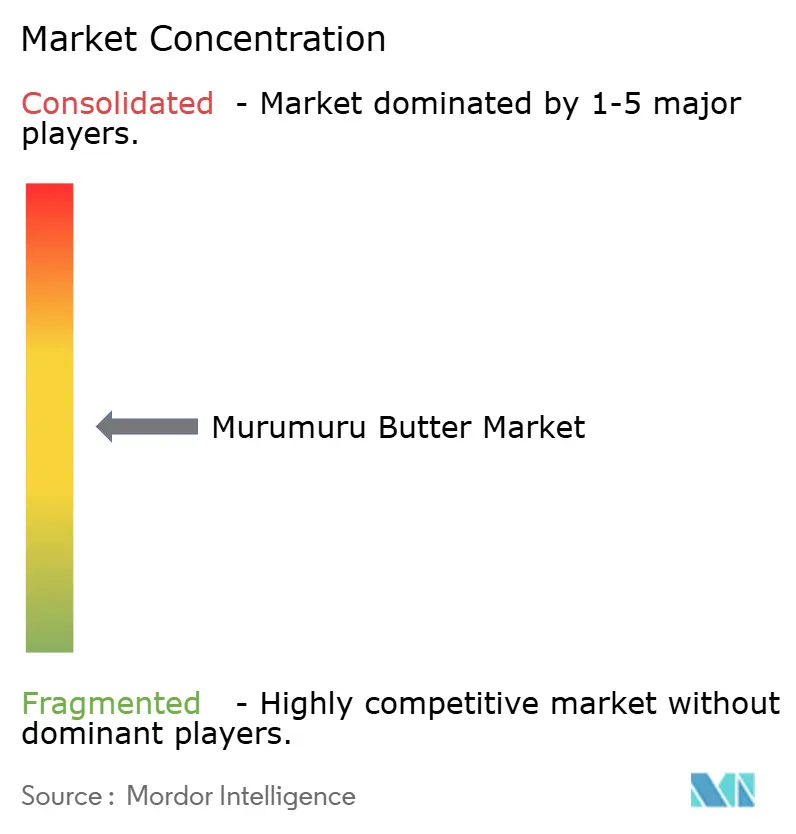
Recent Industry Developments
- April 2025: At in-cosmetics Global 2025, BASF unveiled three new natural-based personal care products: Verdessence® Maize, a biodegradable styling polymer; Lamesoft® OP Plus, a wax-based opacifier; and Dehyton® PK45 GA/RA, a betaine sourced from Rainforest Alliance Certified coconut oil. This move underscores the industry's dedication to sustainable ingredient innovation and responsible sourcing.
- March 2025: At Cosmet'Agora 2025, BASF unveiled its climate-adaptive beauty formulations, underscoring a commitment to sustainability. The new offerings, which prioritize eco-consciousness, tackle hydration, cleansing, UV protection, and natural makeup. These formulations leverage sustainable emollients and biodegradable alternatives.
- January 2025: In line with industry trends emphasizing ethical sourcing and sustainability, Cargill Beauty has introduced a sustainable cocoa butter. This cocoa butter, sourced from Ghana, Cameroon, and Côte d'Ivoire, comes with Rainforest Alliance certification and is marketed as both biodegradable and 100% natural.
- October 2024: The International Finance Corporation (IFC) has injected BRL 6 million (equivalent to USD 1.1 million) into Natura's Amazônia Viva Financing Mechanism. This move aims to bolster the socio-biodiverse economy in the Amazon. The financing mechanism offers cooperatives annual funding at an interest rate of 8%, while also connecting credit access to the market for sourcing sustainable ingredients.
Global Murumuru Butter Market Report Scope
| Organic |
| Conventional |
| Unrefined (Virgin) |
| Refined/Deodorized |
| Personal Care and Cosmetics | Hair Care Products |
| Skin Care Products | |
| Lip Care Products | |
| Others | |
| Pharmaceuticals | |
| Food and Beverages | |
| Home Care Products | |
| Biofuels and Industrial |
| Online Retail |
| Offline Retail |
| North America | United States |
| Canada | |
| Mexico | |
| Rest of North America | |
| Europe | Germany |
| United Kingdom | |
| Italy | |
| France | |
| Spain | |
| Netherlands | |
| Rest of Europe | |
| Asia-Pacific | China |
| India | |
| Japan | |
| Australia | |
| Rest of Asia-Pacific | |
| South America | Brazil |
| Argentina | |
| Rest of South America | |
| Middle East and Africa | South Africa |
| Saudi Arabia | |
| United Arab Emirates | |
| Rest of Middle East and Africa |
| By Category | Organic | |
| Conventional | ||
| By Form | Unrefined (Virgin) | |
| Refined/Deodorized | ||
| By End-User Industry | Personal Care and Cosmetics | Hair Care Products |
| Skin Care Products | ||
| Lip Care Products | ||
| Others | ||
| Pharmaceuticals | ||
| Food and Beverages | ||
| Home Care Products | ||
| Biofuels and Industrial | ||
| By Distribution Channel | Online Retail | |
| Offline Retail | ||
| By Geography | North America | United States |
| Canada | ||
| Mexico | ||
| Rest of North America | ||
| Europe | Germany | |
| United Kingdom | ||
| Italy | ||
| France | ||
| Spain | ||
| Netherlands | ||
| Rest of Europe | ||
| Asia-Pacific | China | |
| India | ||
| Japan | ||
| Australia | ||
| Rest of Asia-Pacific | ||
| South America | Brazil | |
| Argentina | ||
| Rest of South America | ||
| Middle East and Africa | South Africa | |
| Saudi Arabia | ||
| United Arab Emirates | ||
| Rest of Middle East and Africa | ||
Key Questions Answered in the Report
What is driving the current growth of the murumuru butter market?
Demand for plant-based emollients, stricter ingredient-transparency laws, and clean-beauty trends are lifting sales, pushing the market toward a 5.67% CAGR through 2030.
Which region holds the largest share of murumuru butter sales?
North America leads with 37.69% share in 2024, thanks to premium-beauty consumption and supportive FDA regulations.
Why is Asia-Pacific considered the fastest-growing market?
Rising disposable incomes, strong e-commerce adoption, and consumer openness to novel plant ingredients support an 8.31% CAGR in Asia-Pacific through 2030.
Which end-use segment dominates murumuru butter demand?
Personal care and cosmetics account for 71.45% of global consumption, particularly in hair-care and solid-bar products.
Page last updated on:
